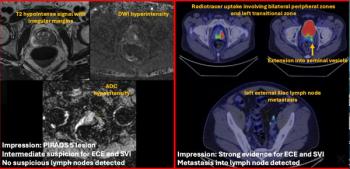
Advances in lung CAD boost overall performance
The latest lung CAD software offers high sensitivity and minimizes false positives greatly. But the lack of full integration with PACS continues to stall routine clinical use in some centers.
The latest lung CAD software offers high sensitivity and minimizes false positives greatly. But the lack of full integration with PACS continues to stall routine clinical use in some centers.
Researchers at the University of Toronto, which is very active in lung CAD research and uses tools from R2 and Medicsight, say the software is not being used in clinical practice. It's not that radiologists doubt CAD's value-far from it.
"It simply takes too much time to use CAD in clinical practice. The big challenge for all vendors is to [fully] integrate software into workstations," said Dr. Heidi Roberts, an associate professor of radiology at the university.
CAD manufacturer R2 says that its latest software package is integrated in the sense that static images and reports can be sent to the PACS for display on any workstation. However, access is not interactive, so users cannot yet add or delete CAD marks, adjust segmentation on a different workstation, or choose 3D views to analyze the potential lesion.
"It is not known when interactive integration of CAD on PACS workstations will occur," said Kevin Kreeger, director of advanced development at R2. "We have been in discussion with multiple PACS vendors about providing plug-ins or modules for them, but they have not gotten very far."
Getting the PACS companies to implement the integration on their end is very difficult, Kreeger said. Interactive integration (as opposed to just sending DICOM objects over) means the CAD and PACS vendor development teams need to synch. That means a business relationship needs to be created, and that takes time.
Nevertheless, Kreeger said that as far as he knows, most of the company's 140 installations are using the tool in clinical practice.
The Canadian researchers are finding latest generation lung CAD software offers much better sensitivity and significantly reduced false positives for detection of pulmonary embolism compared with earlier versions. In a study presented at the 2007 American Roentgen Ray Society meeting, Roberts and colleagues found that CAD alone (ImageChecker CT version 2.1, R2/Hologic) marked all 22 PEs on 100 consecutive CT angiography exams and affixed at least one mark to 62 negative studies. Overall, the positive predictive value for CAD alone was 26%.
Radiologists using CAD found an average of 2.6 false positives per case. More than 40% of false-positive marks were the type that can be easily dismissed, researchers said.
CAD did not improve sensitivity for experienced readers, but it did help less experienced radiologists. The study suggests that CAD could be useful for residents reading chest studies on an on-call basis, Roberts said.
Dr. Myrna Godoy and colleagues from the University of British Columbia, where lung CAD is used routinely in clinical practice, reported lower sensitivity using an earlier version (2.0) of ImageChecker CT to detect lung nodules. The retrospective study involved 69 chest multislice CT scans in 12 people with 15 pathologically confirmed cancers (maximum diameter ranging from 3 mm to 38 mm). CAD registered the following sensitivity results for solid and semisolid lung cancer nodules scanned with CT (slice thickness 1 mm or 1.25 mm):
- 75% for nodules 4 mm to 10 mm;
- 95% for nodules 11 mm to 15 mm;
- 100% for nodules 16 mm to 20 mm; and
- 88% overall.
In another study presented at the ARRS meeting, Roberts and colleagues found that CAD performance varied greatly depending on the protocols used. Using Lung CAR 1.2 from Medicsight, researchers found that optimal performance for nodule detection came with CT scans reconstructed at 1-mm slice thickness with a soft-tissue algorithm. With this protocol, radiologists achieved the following sensitivity rates:
- 95% for nodules smaller than 5 mm;
- 68% for nodules between 5 mm and 15 mm;
- 76% for nodules larger than 15 mm; and
- 83% for all nodules.
Sensitivity was worst in the 5-mm reconstruction series. This particular study was related to cancer detection, but the results have important implications for taking lung nodule measurements over time in cancer patients, Roberts said.
"Follow-up studies should be done with the same machine, the same data acquisition parameters, same field-of-view-same everything," she said.
Newsletter
Stay at the forefront of radiology with the Diagnostic Imaging newsletter, delivering the latest news, clinical insights, and imaging advancements for today’s radiologists.




























